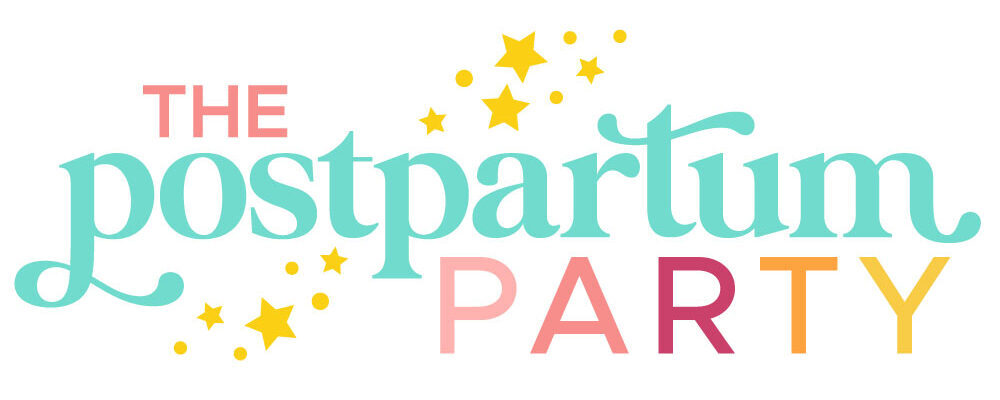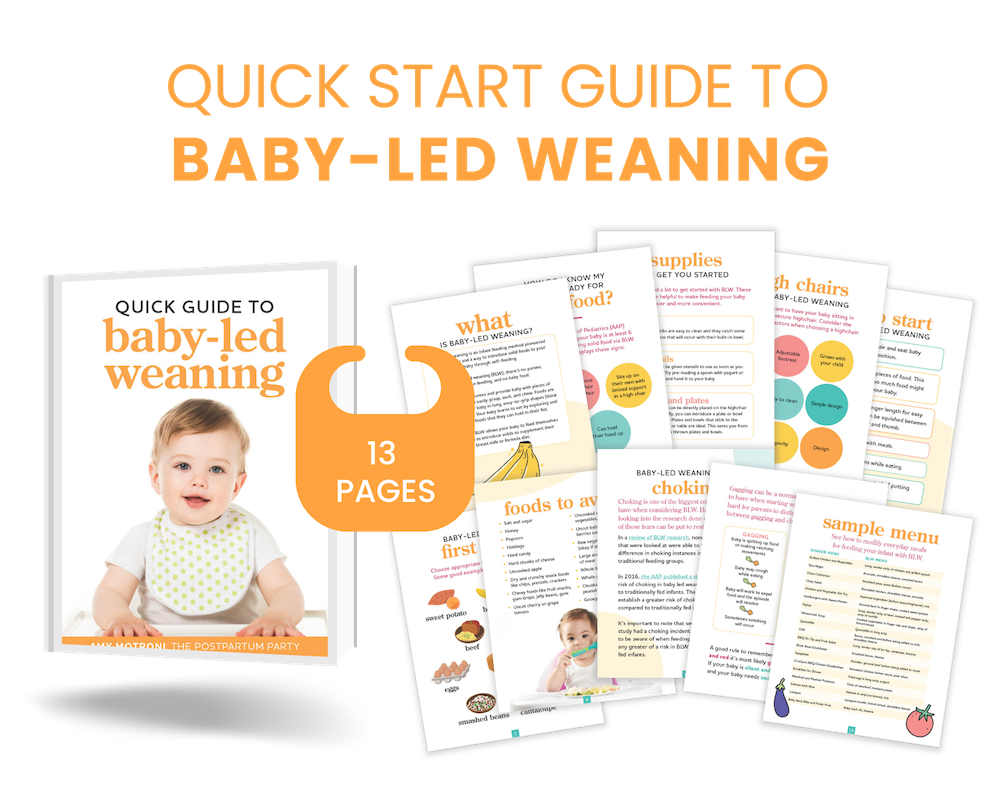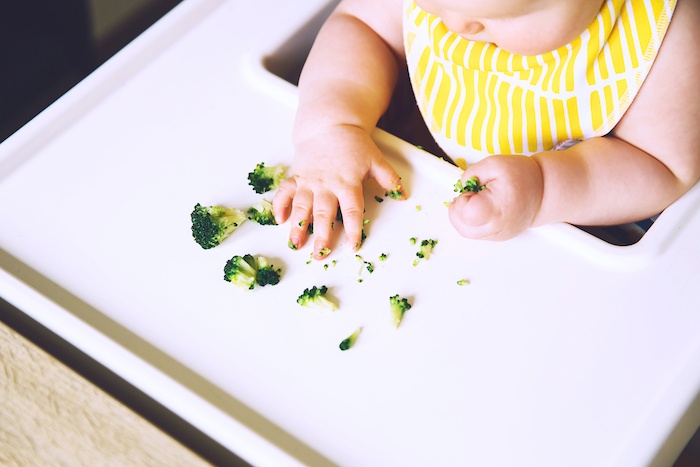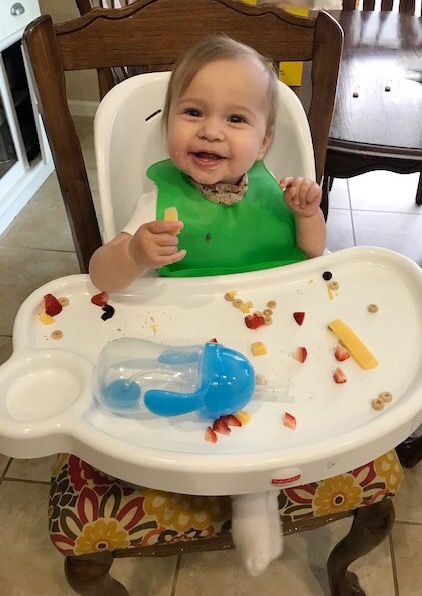Baby Led Weaning (BLW) is a great way to start your baby on solid foods, but many parents have concerns about their baby choking with this method of feeding. Learn the tips to prevent choking with baby led weaning.
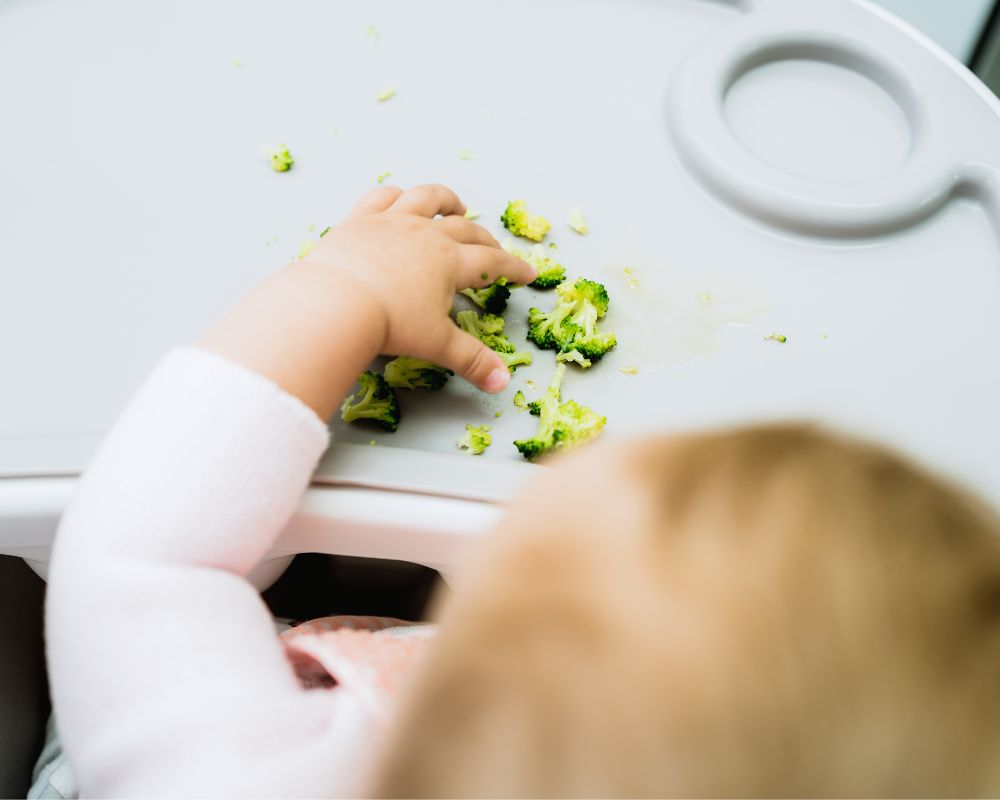
What is Baby Led Weaning?
Baby Led Weaning (BLW) is a method of feeding infants solid foods.
Instead of using traditional pureed foods and spoon feeding your baby, parents and caregivers provide appropriate size and textured table foods so baby can feed themselves.
Baby feeds themselves soft, fry-like shapes of food while parents eat alongside them.
This method continues to grow in popularity as it can help babies become exposed to a variety of foods and can be easier for the parents to prepare than pureed foods.
My family chose BLW with our daughter and we absolutely loved it. Read about the awesome benefits of baby led weaning and why my family loved this way of introducing solids so much!
Can Babies Choke with Baby Led Weaning?
Many parents and caregivers hear about BLW and immediately are concerned with choking.
In fact, it’s one of the main reasons parents state when deciding between baby led weaning vs purees for introducing solids to their baby.
Thoughts like: How can I give my child whole pieces of food and expect them to eat it? How will they not choke by shoving that chunk of meat into their mouth?
These are all rational and logical concerns. Choking is a risk for infants and toddlers learning to eat solid food.
Approximately one child dies every 5 days in the United States from choking on food. Additionally, about 12,000 children go to the Emergency Room each year for food-choking incidents.
While these statistics can be alarming, many of these food-choking incidents can be prevented.
5 Tips to Prevent Choking with Baby Led Weaning
There are ways to introduce solids via baby led weaning while reducing the risk of choking. Here are 5 tips to prevent choking when introducing solids to your baby with BLW.
The first thing to assess in preventing choking is your baby’s readiness to start baby led weaning.
Make sure that your baby is showing the developmental signs to start solids so that you can have the most success with feeding and reduce choking incidents.
Baby-Led Weaning Quick Start Guide
If you’re looking to get started with baby-led weaning, grab the Quick Start Guide to Baby Led Weaning. It has step-by-step instructions on how to start baby led weaning, sample menu ideas, choking prevention tips, and more. Check it out here.
1. Avoid foods that are common choking hazards
The American Academy of Pediatrics (AAP) and the Center for Disease Control (CDC) both recommend to avoid feeding your baby and toddler several food items because of their choking risk.
These items include:
- Nuts and seeds
- Chunks or spoonfuls of peanut butter
- Large chunks of cheese
- Large and tough pieces of meat
- Whole beans
- Hot dogs
- Uncut grapes
- Pieces of raw, hard fruits and vegetables, like carrots or apples
- Popcorn or raw corn kernels
- Uncut cherry or grape tomatoes
- Uncut balls of fruit like berries, melon
- Uncooked dried fruit or vegetables, like raisins
- Dry and crunchy snack foods like chips, pretzels, crackers
- Chewy foods like fruit snacks, gum drops, jelly beans, gum, marshmallows
- Round and hard pieces of candy
2. Choose appropriate foods in size and texture
When feeding foods using the baby led weaning method, provide foods that your infant can easily hold and squish.
A good rule is to cut food into finger-length pieces so your baby can grasp it with their whole fist.
Make sure you can squish it between two fingers so that your infant can easily gum, gnaw, suck, and chew it. Check out these great first foods for baby led weaning to give you ideas on which foods to get started with!
3. Decrease distractions while eating
Introducing solids can be such a fun milestone! One of the perks of baby led weaning is that the whole family can sit and eat together at the same time.
While your baby is eating, limit distractions so that everyone can focus on the food and company in front of them.
Don’t allow games, toys, or screens to make an appearance during meal and snack times. This means for parents as well.
4. Supervise meal times
When the whole family eats meals and snacks together, this allows you to safely supervise your infant eating.
Eating together also allows for great modeling of all family members eating. It provides family meal times, which have proven to be so beneficial for your child’s growth and development.
5. Seat baby in a safe position
Utilizing the correct type of chair for your infant is vital to ensure they are eating safely. Your baby should be placed in a high chair that allows your child to sit upright and has a stable foot rest.
See my list of the best highchairs for BLW if you need help choosing a chair.
Choking VS Gagging
Being able to understand the differences between choking and gagging can be a true life-saver, not only for your baby, but for your sanity as well!
Gagging is actually a really common and normal part of infant development. To help yourself be more comfortable with this part of infant feeding, there are some key differences between gagging and choking that parents and caregivers can recognize.
In gagging
- Baby is spitting up food or making retching movements
- The infant may often cough while eating
- Baby will work to expel food and the episode will resolve
- Sometimes vomiting will occur
But in choking
- The airway is blocked and there is little to no sound or breathing
- Baby will have trouble coughing (or not be able to cough at all)
- Immediate action is needed to help remove the item from airway
A good rule to remember is that if your baby is LOUD and RED it’s most likely gagging and it will resolve.
If your baby is SILENT and BLUE, choking is occurring and your baby needs immediate attention.
Research Around Baby Led Weaning Choking
It is really common and a normal feeling to be fearful of your infant choking while eating. A few studies have been done on this topic and may help decrease fears around choking among BLW infants.
First, a study published in the Journal of Human Nutrition and Dietetics had mothers self-report the type of feeding style they used and the instances of choking that their baby had.
From the mother’s responses, BLW was not associated with an increased risk of choking. And actually, the infants that were given finger foods the least had the highest frequency of choking on finger foods.
Additionally, in a separate randomized controlled trial published in Pediatrics (the American Academy of Pediatrics publication), researchers compared choking incidents with infants fed in a traditional approach vs a BLW approach that provided education on preventing choking incidents.
The infants in the BLW group did not appear more likely to choke than their traditionally fed peers. The study did note that a large number of infants were at potential risk of choking.
The Risk of Baby Led Weaning Infants Choking
All this research points to the fact that yes, choking is a real danger to infants and toddlers.
But it is NOT more likely to occur in BLW infants. Choking can occur just as frequently, if not more, in infants that are spoon-fed purees.
Additionally, parents and caregivers that educate themselves and implement safe practices for BLW (which I mention above) can protect their infant from a potentially life-threatening choking incident.
Infant and Child CPR
One of the best things that parents can do to safely feed their infant is to take an Infant/Child CPR class. These classes will give parents and caregivers hands on practice and skills to know how to respond in the event that your baby chokes while eating.
This CPR class from Safe Beginnings is 100% online and more affordable than many options because it teaches caregivers the skills, without providing an actual certification. Use my code postpartumparty to save 20%.
Hopefully you now feel like you have the information and guidance needed to safely use BLW to feed your baby.
It can be scary to attempt BLW for your infant and that is normal. But have confidence that with these tips to prevent choking you can safely use baby led weaning for your baby!
- 4 Reasons Your Baby Only Naps 30 Minutes (And What to Do) - April 22, 2024
- Sample 8-Month-Old Sleep Schedule (With Naps, Feeds, and Solids) - April 22, 2024
- Newborns and Swaddling (Safety Tips) - March 19, 2024
